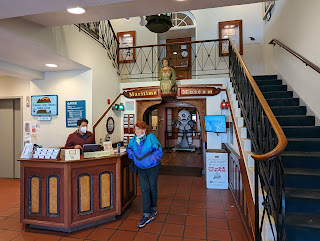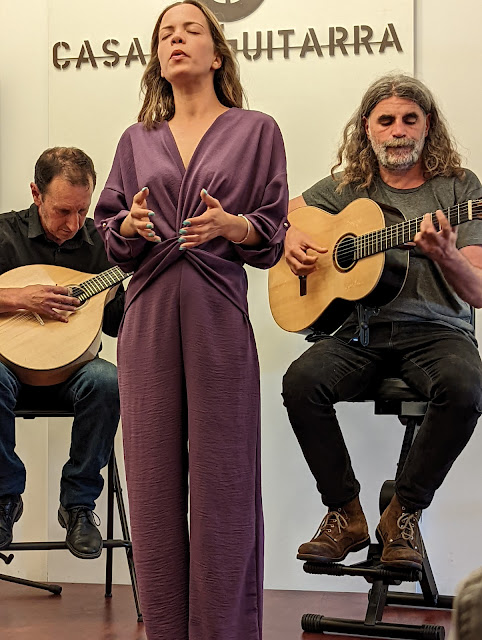 |
| A fine collection of seafaring artifacts combines with beautifully curated changing exhibits to show off Santa Barbara's proud maritime tradition and encourage preservation of the oceans. All ages welcome. |
 |
School children enjoy the interactive
aspect of the education oriented museum. |
UNIQUE MARITIME HERITAGE ON VIEW IN FAMILY ORIENTED MUSEUM WHICH EXPLORES WONDERS OF OUR FINE SEAS
IF THE MENTION of a maritime museum conjures thoughts of yellowing, ragged sails, salty old sea captains and outdated maps of long ago sailing days, think again.
And head for the Santa Barbara Maritime Museum.
It's a jewel of a museum with a lively, contemporary spin on nautical life and an environmentalist's take on that precious, endangered commodity -- vital to our life -- the sea. Its beauty and importance are colorfully celebrated in this wondrous place, where all ages are educated about the sea's history and its critical contributions to our daily life.
 |
Christene "Cookie" Meyers pauses at the reception
desk during a visit exploring the sea's wonders. |
CALIFORNIA HAS one of the country's longest and most colorful maritime collections and the staff at this lively museum knows this fact as it proudly shares the museum with tourists from all over the world.
Says Rita Serotkin, director of marketing and public relations at the museum, "We provide a forum for education and enlightenment" -- both of which we found to be true as she guided us through two stories of fascinating sea lore and lessons.
We found the museum a joy to visit because it really has personality. It is warm, welcoming and friendly. While many museums are a bit cold, austere and "stand-offish," the Santa Barbara facility has an inviting aura.
 |
Photographer Bruce Keller becomes the subject briefly
on Santa Barbara's picturesque oceanfront by the museum. |
On our visit, we observed a lively mix of children, families, touring couples, sportsmen, "a fun mix of seafaring adventurers," as my sailor partner and photographer Bruce Keller observed.
THE RANGE of programs includes presentations by native people whose connection to the sea goes back centuries. Chumash Elder Puchuk Ya’ia’c (Alan Salazar) visited the museum in November to discuss “Chumash Maritime History—Past, Present, & Future” and encored recently with fellow writer and historian, Mona Lewis, to read from their new book, "Coyote Rescues Hawk." As with man of the museum's events, the presentation encouraged
 |
| Right outside the door of the museum, boats of every kind await. |
audience participation. This time, participants created their own traditional seaweed rattles for a reasonable $25, including all materials for the artful project.
Another presentation sets the record straight on who was first to complete a trans-Pacific voyage. (Hint: it was not Magellan! It was a little known Afro-Portuguese pilot, Lope Martín.)
As Serotkin explains, the museum's mission covers a wide range of ambitious goals -- involving children, entertaining adults and curious visitors, keeping its volunteer corps engaged and active, raising awareness, applying for grants, courting authors, getting the word out on upcoming programs and exhibits and beating the drum for important funding.
WE URGE visitors to make a pilgrimage to both floors where we learned about early Santa Barbara explorers -- Juan Cabrillo, who also explored our San Diego area.
 |
A Fresnel lighthouse lens offers beautiful shapes and colors.
. |
The Chumash people are celebrated, along with whaling, the town's waterfront, and the birthplace of deep sea commercial diving. We also enjoyed elegantly crafted ship models by Dwight Brooks and learned about famous local shipwrecks.
Oil spills, commercial fishing and Channel Islands ranching are also highlighted.
THE MUSEUM has garnered awards for its fun, interactive maritime exhibits for kids as well as adults.
 |
The interactive visits include hands on and multi-media
exhibits with an array of fine displays including photos.
|
Families are encouraged to visit. During our afternoon sojourn, we observed happy three generation groups, students and couples.
We also wandered the wharf, had a delightful lunch at one of the great seafood restaurants, rented a boat for an afternoon jaunt and bought reasonably priced souvenirs at two of the shops.
We recommend making a day outing to explore this important and artful museum -- nestled in the fascinating and historic Santa Barbara Harbor.
MORE INFORMATION:
www.sbmm.org
805 962-8404
 |
A fado singer in Porto appears to be in a trance as she performs,
surrounded by the two classic guitar accompanists. On the left is the
Portuguese guitar playing the melody and intricate counterpoints.
On the right is the bass and rhythm guitarist providing those elements. |
UP NEXT: Porto's fabulous Casa de Guitarra is a fascinating Museum of the Guitar, focusing on the instrument which is integral to Portuguese music. Fado singers must have the two guitars -- the traditional Portuguese guitar, left, and the rhythm and bass guitar, right. Many clubs and bistros feature a fado singer or two on the program and we highly recommend guests take in a fado show while in Portugal. Both Lisbon and Porto offer many options. We'll explore several of the clubs and talk about the art form next week. Meanwhile, remember to explore, learn and live and catch us weekly for a fresh spin on music, theater, nature, family, travel and more.
www.whereiscookie.com
































